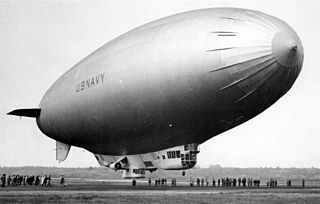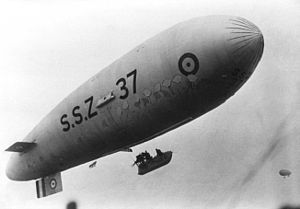
A blimp, or non-rigid airship, is an airship (dirigible) without an internal structural framework or a keel. Unlike semi-rigid and rigid airships, blimps rely on the pressure of the lifting gas inside the envelope and the strength of the envelope itself to maintain their shape.

The G-Class Blimps were a series of non-rigid airships (blimps) used by the United States Navy. In 1935, instead of developing a new design airship, the Navy purchased the Goodyear Blimp Defender for use as a trainer and utility airship assigning it the designator G-1. Defender was built by the Goodyear Aircraft Company of Akron, Ohio and was the largest blimp in the company’s fleet of airships that were used for advertising and as passenger airships. Goodyear built additional G-class airships for the Navy during World War II to support training needs.

The L class blimps were training airships operated by the United States Navy during World War II. In the mid-1930s, the Goodyear Aircraft Company built a family of small non-rigid airships that the company used for advertising the Goodyear name. In 1937 the United States Navy awarded a contract for two different airships, K class blimp designated K-2 and a smaller blimp based upon Goodyear's smaller commercial model airship used for advertising and passenger carrying. The smaller blimp was designated by the Navy as L-1 The L-1 was delivered in April 1938 and operated from the Navy's lighter-than-air facility at Lakehurst, New Jersey. In the meantime, the Navy ordered two more L-Class blimps, the L-2 and L-3, on September 25, 1940. These were delivered in 1941. L-2 was lost in a nighttime mid-air collision with the G-1 on June 8, 1942.

The Goodyear Aircraft Company of Akron, Ohio built the M-class blimp for the US Navy as the follow-on to the K-class anti-submarine warfare blimp used during World War II. It was a significantly larger airship, 50% larger than its predecessor. Four airships, designated M-1 through M-4, were delivered in early 1944. Operations of K-ships in tropical regions had shown a need for a blimp with greater volume to offset the loss of lift due to high ambient temperatures.

Beginning in 1908 and lasting until 1937, the U.S. Army established a program to operate airships. With the exceptions of the Italian-built Roma and the Goodyear RS-1, which were both semi-rigid, all Army airships were non-rigid blimps. These airships were used primarily for search and patrol operations in support of coastal fortifications and border patrol. During the 1920s, the Army operated many more blimps than the U.S. Navy. They were also used because they were not seen as "threats".

The B class blimps were patrol airships operated by the United States Navy during and shortly after World War I. The Navy had learned a great deal from the DN-1 fiasco. The result was the very successful B-type airships. Dr. Jerome Hunsaker was asked to develop a theory of airship design, Lt. John H. Towers had returned from Europe having inspected British designs, and using reports from attachés on British airship operations, the Navy was prepared to seek bids for blimps from American manufacturers. On 4 February 1917 the Secretary of the Navy directed that 16 nonrigid airships of Class B be procured. A February 12, 1917 meeting with the Chief of the Bureau of Construction and Repair, and representatives of Goodyear, Goodrich, Connecticut Aircraft Company, Curtiss Aeroplane and Motor Corporation, and U.S. Rubber Company, it was agreed that the order for 16 dirigibles was beyond the capability of any one company. The conference resulted in a committee to coordinate on sharing raw materials, information and experience. Ultimately Goodyear manufactured 9 envelopes, Goodrich made 5 and Curtiss assembled the gondolas for all of those 14 ships. Connecticut Aircraft contracted with U.S. Rubber for its two envelopes and with Pigeon Fraser for its gondolas. The Curtiss-built gondolas used by Goodyear and Goodrich used modified Curtiss JN-4 fuselages powered by Curtiss OXX engines. The Connecticut Aircraft blimps were powered by Hall-Scott engines. One ship, B-20 was equipped with a special control car. All B-Class airships were delivered to the Navy between August 1917 (B-1) and September 1918 (B-20).

The C-class blimp was a patrol airship developed by the US Navy shortly after World War I, a systematic improvement upon the B-type which was very suitable for training, but of limited value for patrol work. Larger than the B-class, these blimps had two motors and a longer endurance. Once again, the envelope production was split between Goodyear and Goodrich, with control cars being built by the Burgess division of Curtiss Aeroplane and Motor Company. Originally the Navy ordered 30 but reduced the number to 10 after the armistice in November 1918. All ten of the "C" type airships were delivered in late 1918, and examples served at all of the Navy's airship stations from 1918 to 1922. In 1921 the C-7 was the first airship ever to be inflated with helium. The Navy decommissioned its last two remaining C-type blimps, the C-7 and C-9 in 1922.

The D class blimp was a patrol airship used by the US Navy in the early 1920s. The D-type blimps were slightly larger than the C-type and had many detail improvements. The Navy continued the practice of dividing the envelope production between Goodyear and Goodrich. The control cars were manufactured by the Naval Aircraft Factory. The major improvements over the C-type blimps were a better control car design and easier, more reliable controls and instrumentation. The engines were moved to the rear to reduce noise and allow better communications between crew members. The fuel tanks were suspended from the sides of the envelope. The envelope was identical to the C-type, except an additional six-foot panel was inserted for a total length of 198 feet (60 m) and a volume of 190,000 cubic feet (5,400 m3). The last of the D-Class, D-6, had a different control car designed by Leroy Grumman who later founded the Grumman Aircraft Engineering Corporation.

The E class of US Navy blimps comprised a single airship, built during World War I by Goodyear as one of a group of three small blimps offered to the US government. Two were purchased for the US Navy and one for the US Army. The Navy blimps were designated E-1, F-1, and the Army airship A-1. These airships had identical envelopes but different cars. The E-1 was delivered to Pensacola, Florida in December 1918. It was flown only at Pensacola serving as a trainer at the Airship School. A new envelope was provided in December 1920. E-1 was retired from service sometime in 1924.

The F class of US Navy blimps comprised a single airship, built during World War I by Goodyear as one of a group of three small blimps offered to the US government. Two were purchased for the US Navy and one for the US Army. The Navy blimps were designated E-1, F-1, and the Army airship A-1. Classified as an "Experimental Engine Testing Dirigible." F-1 had the same envelope size as the E-1, due to the use of a tractor mounted 125 hp Union engine, the performance was different. F-1 spent its entire career at Hampton Roads. It was flown in both tractor and pusher configurations. It also may have been flown with a Curtiss OXX engine. F-1 was removed from inventory in November 1923.
The K-1 was an experimental blimp designed by the United States Navy in 1929. Due to the inability to get Congressional approval for the construction of an airship the navy used the ploy of ordering a "universal" control car which could be used on the J-type airships from the Naval Aircraft Factory. An order was placed with Goodyear Tire and Rubber Company for an envelope to hold "experimental gases". To complete the deception, there is no record of the US Navy assigning a serial number to the K-1, Standard Army TC type tail fins were procured from Goodyear. Unlike past Navy blimps, the control car was not suspended from external cables, but was hung from cables attached to the top of the envelope, and the car was carried flush against the envelope as in modern blimps. The control car carried bunks and a galley so that a relief crew could be carried, and was completely enclosed. The K-1 was also the first Navy blimp to have a taxi wheel. Like the Graf Zeppelin, the fuel for the K-1 was "blau gas" a mixture of combustible gases with the same density as air, which meant that the valving of gas as the fuel was consumed was not necessary. The only serious drawback was the tendency of the fuel to leak into the helium which then could not be run through the Lakehurst purification plant, which meant the expensive helium had to be vented to atmosphere when too contaminated or an overhaul was necessary.

During the First World War, the US Navy trained crews at British bases, and operated British designed and built blimps on combat patrols. The Navy purchased three types of British blimps. Operations were flown in a US SSZ and airships operated by the Royal Navy.
Records concerning the history of French airships in US Navy service are fragmentary. A number of airships of various classes were operated by the US Navy (USN) during World War I from the French Naval Base at Paimbœuf, which was designated a US Navy Air Station from 1 March 1918 onward. It appears that at least 13 French manufactured airships were operated by the USN from Paimbœuf; six were eventually shipped to the United States and one was returned to France before the armistice. The Navy operated or ordered four Astra-Torres type airships, one T-2—the Captain Caussin, two CM types, and three or four VZ types.

The British R.23X class of rigid airships were developed during World War I using the experiences gained from the 23 class, but only two of the planned four R.23X class were built: R.27 and R.29. Both were completed mid-1918, but just two-and-a-half months after entering service R.27 was destroyed by fire in a hangar; while R.29 went on to become the most successful British wartime rigid airship, being the only one to meet enemy action, as well as the only one to sink a submarine.

SSclass airships were simple, cheap and easily assembled small non-rigid airships or "blimps" that were developed as a matter of some urgency to counter the German U-boat threat to British shipping during World War I. A secondary purpose was to detect and destroy mines. The class proved to be versatile and effective, with a total of 158 being built in several versions.
The SSP were a class of Royal Navy non-rigid airship or "blimp" developed by the United Kingdom during World War I as a successor to the earlier SS class airship. Found to be inferior to a parallel development, the Submarine Scout Zero non-rigid, only a few were built. The main role of these craft was to escort convoys and scout or search for German U-boats.
The SST class of non-rigid airship or "blimp" was developed in Great Britain during World War I from the earlier SS class airship. The main role of these craft was to escort convoys and scout or search for German U-boats. A secondary purpose was to detect and destroy mines.

The British NSclass non-rigid airships were the largest and last in a succession of "blimps" that served with the Royal Naval Air Service during World War I; developed from experiences gained with earlier classes to operate off the east coast of Britain on long-range patrols. Despite early problems, examples of the class went on to break all flying records for non-rigid airships, and the type became regarded as the most efficient of its kind.

RNAS Capel was a First World War airship station near Folkestone, Kent.


















